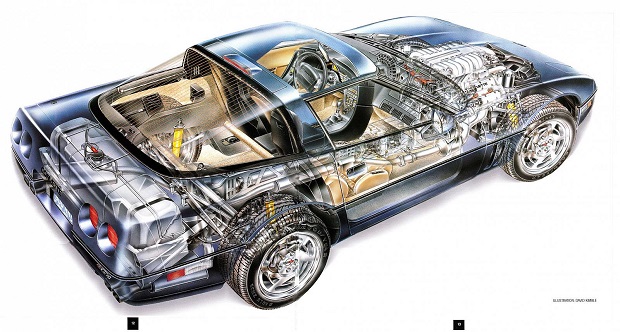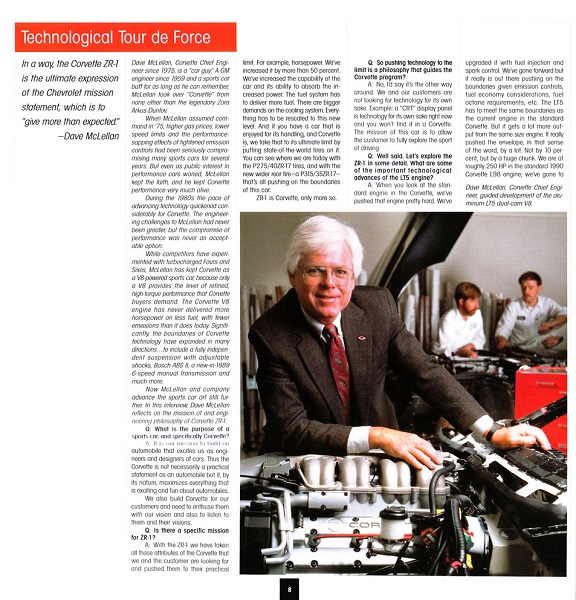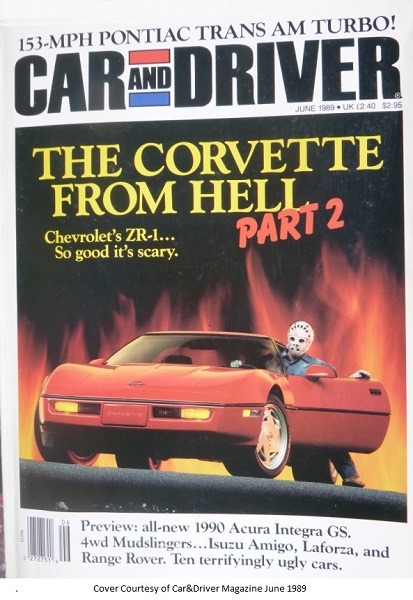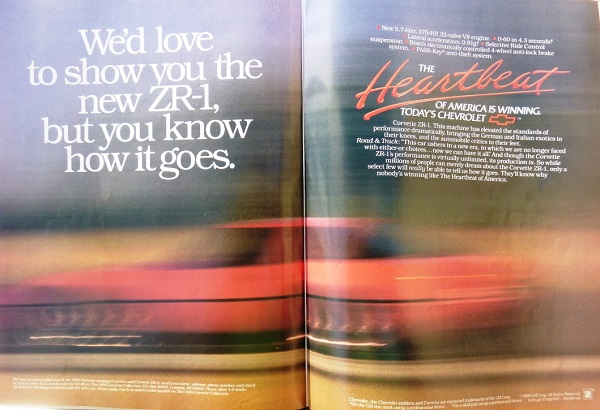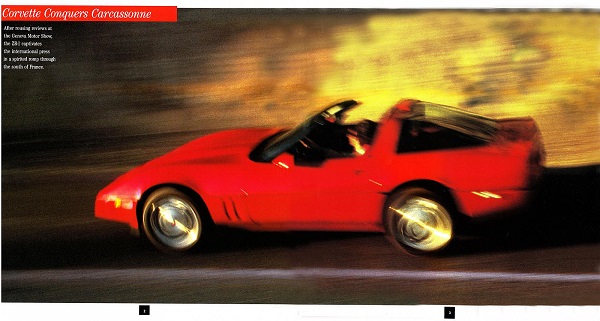Corvette History through Ads: 1990 ZR1 Reestablishes Corvette’s Performance Foundation
The development and production of the ZR1 were far more significant to the Corvette than you’d expect from just another new trim level and its implications were vitally important to the future survival of the Corvette. When the fourth generation Corvette was unveiled the very definition of a “performance” car was being challenged in light of the strict government regulations in regards to fuel economy and safety. Upon the fourth generation’s introduction Dave McLellan, Corvette’s Chief Engineer, went on record redefining what “performance” meant for sports cars and specifically the new generation Corvettes. Government regulations forced auto manufacturers to rethink the very concept of a performance car. Rather than focusing on maximizing horsepower, performance cars of the future would require more attention to handling, suspension tuning and chassis development.
Production engines that could deliver both massive amounts of horsepower and torque and at the same time meet emissions requirements were just not available throughout much of the 80’s. When the development and technology for high horsepower, fuel efficient engines improved, the C4 was the perfect sports car to add the high horsepower engine. The new car could deliver massive horsepower, for that time period, combined with the world class handling and braking capabilities engineered into the C4. When the ZR1 was introduced in 1990 it not only satisfied the needs of “performance starved” enthusiasts, it laid the foundation and raised the bar for future Corvettes.
The 1990 ZR1 was the only Corvette ever built with a European designed engine, which placed it in direct competition with the era’s supercars from Ferrari and Lamborghini that cost several times more than the ZR1. The 5.7L V8 engine was designed by the Grand Prix race car builder, Lotus, and developed 375 horsepower, a staggering 130 horsepower jump over the standard engine in the 1990 Corvette. McLellan was quick to boast that the ZR1 was, in many ways, comparable to sports cars costing up to five times the cost of the ZR1. The exotic dual cam, 32-valve engine was hand built in Stillwater, Oklahoma, by Mercury Marine, a company that had developed a reputation for precision engine building.
But the price of an “exotic” didn’t come cheap and required an introductory price of almost $59K, which quickly jumped to over $64K, a $27,016 premium over the base Corvette. The ZR1 Corvette, known as “King of the Hill” was the most expensive car in General Motors lineup. But it did not deter buyers. In fact, several dealers and private sellers were asking and getting over $100K for one of the 3,049 ZR1’s produced the first year.
And the ZR1 walked the walk. The car tripped the ¼ mile clock consistently under 13 seconds and hit 60 MPH in the mid 4 second range, a major improvement over the base car. In 1990 the ZR1 set three world’s speed/endurance records, averaging over 175 MPH for twenty four hours, and also broke twelve international class records.
Surprisingly, the introduction of the “exotic” ZR1 did not unleash a flurry of advertisements introducing the car as might be expected. Road tests and commentaries in the “buff” magazines supplied much of the hype on the ZR1. Unlike introductions in prior years when print media was barraged with advertisements about new features, specifications, and performance capabilities, it wasn’t the case with the ZR1. The budget simply wasn’t there for huge advertising expenditures on low volume cars like the ZR1 or even the Corvette.
GM was experiencing some of the toughest financial times in their history, losing over $2B in 1990, so budgets were revised to fund advertising for GM’s bread and butter cars. The Corvette budgets were slashed reallocating the dollars to help defray the costs to advertise high volume cars and help revive lagging sales and stem the rising tide of the competitive import market. The Corvette’s advertising budget wasn’t the only victim as the C4’s budgets were slashed including the development budget for the next-gen Vette. The very future of the Corvette was on the line and in jeopardy of being dropped.
Other than very minimal advertising of the ZR1 during the initial introduction, advertising dollars were redirected to other volume models like the Oldsmobile Cutlass and more profitable models like the Cadillac Seville. Much of the ZR1’s introductions would be handled by the positive reviews and road tests from the media. It also allowed what limited dollars were available for marketing the Corvette to be used in other ways, like event sponsorship, particularly racing. In retrospect, this change set a precedent for Corvette advertising for years to come by limiting print exposure and expenditures except during new generation unveilings and using the press and media to help promote the car. Relying on road tests and comparisons for promotion increased credibility far beyond what corporate-produced and paid-for advertisements could achieve. It also placed much greater responsibility upon the engineers and designers to continually build a better car in all aspects.
A review of Car & Driver’s November 1989 issue revealed a two-page advertisement for the new ZR1 as well as several pages for other GM models. In the November 1989 issue of C&D several two facing-page advertisements (known as double truck ads) appeared for a few other GM products as well as the ZR1: the Cadillac Seville, the Chevrolet Lumina, the Oldsmobile Toronado Trofeo, and the inside cover foldout which advertised the new, two-sided galvanized, corrosion resistant coatings Chevrolet introduced. Additionally, Pontiac was represented with a single page ad for the Bonneville SSE. But the brief advertising presence for the Corvette and ZR1 in the fall of 1989 was short lived and was almost non-existant after that period. A review of the same issue of C&D a year later (1990) found no Corvette advertising and severely reduced GM advertising overall, most likely due to the projected 1991 loss of $4B.
Realizing that educating the traditional Corvette customer was essential to justifying the ZR1’s high price tag and saddled with a severely limited advertising budget, the two page ad in the fall of 1989 was supplemented with a very limited, high quality multiple page brochure. In the piece, McLellan was interviewed explaining the innovative concepts and capabilities of the ZR1.
During 1989, the enthusiast magazines were thoroughly impressed with the new ZR1 and praised not only the performance but the high build standards. Car & Driver, a magazine that refused to test the 1968 C3 because of shoddy build quality, was singing a different song about the ZR1. Their June issue featured the ZR1 on the cover calling it “The Chevrolet From Hell” and in their rave review said, “It’s out of the park, over the centerfield stands. The fans are chanting, Chev-ee, Chev-ee!” Interestingly in the same issue they tested the C4 convertible, calling it “more of the same” and not as good as the Toyota Supra. But in their summary of the ZR1 they said, “The single-minded effort toward a common goal–performance excellence–put forth by the Corvette engineering team should be an example to the entire American industry.” Chevrolet could never have produced an advertisement or paid enough money to get that kind of positive exposure for their new car.
History now shows how close the Corvette came to becoming extinct during the difficult years of the late 80’s and early 90’s. At the time Corvette’s peril was known only to a few inside General Motors. But it took the dedicated efforts of more than a few GM employees to convince the powers inside the corporation to continue America’s sports car. In no small part, the ZR1, unbeknownst to many at the time, played a major role in saving the Corvette for future generations.

